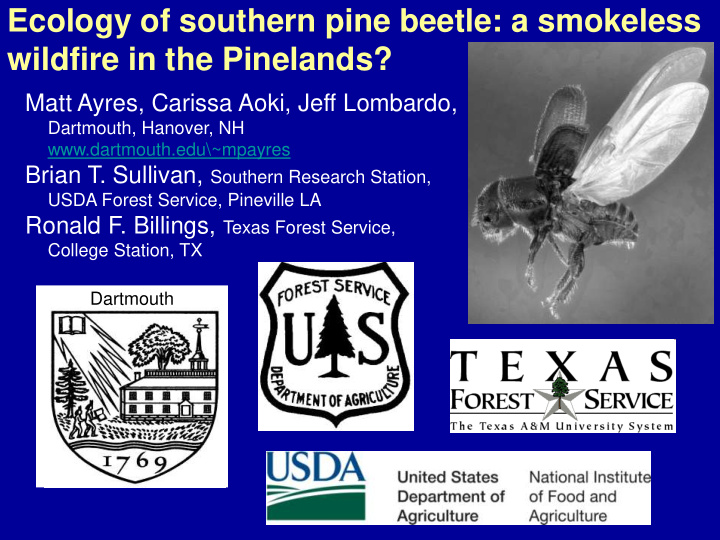



Ecology of southern pine beetle: a smokeless wildfire in the Pinelands? Matt Ayres, Carissa Aoki, Jeff Lombardo, Dartmouth, Hanover, NH www.dartmouth.edu\~mpayres Brian T. Sullivan, Southern Research Station, USDA Forest Service, Pineville LA Ronald F. Billings, Texas Forest Service, College Station, TX Dartmouth
Southern pine beetle Dendroctonus frontalis
e.g., Dendroctonus in North America
New Jersey Pines, Dec 2010
Whitehall Road October 2011 (Bob Williams)
Episodic outbreaks No. of infestations 16000 TEXAS 14000 12000 10000 8000 6000 4000 2000 0 1960 1970 1980 1990 2000 Year
Standardized pheromone trapping survey 1988 1995 1989 1990 1991 1992 1993 1994 1996 1997 1998 1999 2000 Ronald Billings, Texas Forest Service 1987
Bankhead National Forest, AL: 80 km 2 infested during 1998-2000
Bankhead National Forest, AL 80 km 2 infested during 1998-2000 ~10,000 truckloads of finished lumber worth $50-80 million Link to Ylioja et al. 2005. Forest Science .
Smokeless wildfires? Whitehall Road October 2011 (Bob Williams)
Smokeless wildfires? C 6 H 12 O 6 + 6O 2 6CO 2 + 6H 2 0 Whitehall Road October 2011 (Bob Williams)
Smokeless wildfires? C 6 H 12 O 6 + 6O 2 6CO 2 + 6H 2 0 • Episodic and contagious. • Kills small to very large tracts of trees. • Reduces extent of mature forest. • Alters biodiversity. • Creates hazard trees. • Lowers property values. • Reduces recreational opportunities. • Destabilizes hydrology. • Alters N cycling. • Releases stored carbon from ecosystem. • Can change forest type (e.g., pines to hardwoods; forest to scrub). Whitehall Road October 2011 (Bob Williams)
Relevant to: biodiversity, wildlife, recreation aesthetics, conservation biology, fire management, water quality, economics, carbon storage …
Forest Climate management Fungal Interspecific interactions Tree Forest competition defenses structure Specialist predator Abundance Scramble competition Year
Aggregation pheromones - Mass attack
Tree oleoresin
Verbenone Myrtenol Endo-brevicomin
N = beetle abundance R = per capita population change N R
Link to dynamic visualization of spot growth
Photosynthesis Carbohydrates (g / tree) Growth Pete Lorio Growth-differentiation balance hypothesis Secondary Loomis 1932, Lorio 1986, metabolism Herms and Mattson 1992, Wilkens et al. 1997, Warren et Water or nutrient al. 1999, Lombardero et al. 2000 availability
Predation Turchin, P., A. D. Taylor, and J. D. Reeve. 1999. Dynamical role of predators in population cycles of a forest insect: an experimental test. Science 285: 1068-1071.
Intraspecific competition 0.8 Probability of survival 0.4 0 0 50 100 Eggs / dm2 Reeve, J. D., D. J. Rhodes, and P. Turchin. 1998. Scramble competition in southern pine beetle (Coleoptera: Scolytidae). Ecol Entomol 23: 433-443.
Oviposition and inoculation
Mycangium of D. frontalis Photomicrographs by Stan Barras
Mycangium Mutualistic fungus
Insect – fungal interactions Ophiostoma minus & Dendroctonus frontalis Ayres et al. 2000. Ecology Lombardero et al. 2000 Ag. & For. Entomol Klepzig et al. 2000. Symbiosis Lombardero et al. 2002 Oikos Hofstetter et al., Oecologia , in press
O. minus is an antagonist of D. frontalis 30 Outside O. minus bluestain 25 Number of samples 20 Within O. minus bluestain 15 10 5 0 0 10 20 30 40 50 60 70 80 90 100 Survival of D. frontalis larvae (%)
Tarsonemus mites are mutualists with O. minus
Link to video Tarsonemus mites
Tarsonemus krantzi Sporotheca
Tarsonemus krantzi Ascospores of O. minus
Other phoretic micro-associates Link to video
Tarsonemus mites + + Ophiostoma minus - - Mycangial fungi + + D. frontalis + - An interaction Pine tree chain
Whitehall Road October 2011 (Bob Williams)
Lower lethal temperatures 5 Temperature (°C) 0 -5 -10 SCP = -12 °C = LLT -15 -20 -25 Time (min)
pupae adults larvae prepupae Lombardero, Ayres, Ayres, Reeve. 2000. Env. Entomol. Tran, Ylioja, Regniere, Billings, and Ayres. Ecological Applications , 2007
Recent epidemics in north New Jersey 2001-2010 Ohio 2000-2001 Kentucky 1999-2000
Minimum winter temperature in southeastern U.S. has increased 3.3 °C in 40 years 6 4 2 0 °C (residuals) -2 -4 -6 -8 1960 1970 1980 1990 2000 Year Tran, Ylioja, Regniere, Billings, and Ayres. Ecological Applications , 2007
Southern pine beetle New Jersey
Dendroica caerulescens 60 Birds / 64 ha 40 20 Richard Holmes et al., Dartmouth, Hubbard Brook Forest 0 1985 1990 1995 2000 2005 2010 Dendroctonus frontalis No. of infestations 16000 TEXAS 14000 12000 10000 8000 6000 4000 2000 0 1960 1970 1980 1990 2000 Year
R t = f ( N t ) + ε t N t+1 = N t ∙ exp( R t )
Multiple equilibria model Per capita growth rate + 0 - Population size
Multiple equilibria model Per capita growth rate Stable Stable equilibrium equilibrium + 0 - K endemic K epidemic Population size
Multiple equilibria model Per capita growth rate Unstable equilibrium Stable Stable equilibrium equilibrium + 0 - Escape K endemic K epidemic threshold Population size
Sharon Martinson And Ron Billings, Tiina Ylioja, Brian Sullivan
R , per capita growth + 0 - N , Abundance
Carissa Aoki
Jeff Lombardo High basal area stand Windspeed (km / h) Low basal area stand Date
Becky Niemiec: ecological economics of SPB in The Pinelands Advised by Professor Richard Howarth, Environmental Studies, Dartmouth. Rich’s homepage
Milo Johnson Link to Milo’s blog from The Pinelands
Charlie Governali: predators of southern pine beetle
R , per capita growth + 0 - Environment affects strength and domain of alternate attractors N , Abundance
Adaptive management Theoretical model, uncertainty Management Management System challenge response response Repeat as needed
Climate Bluestain fungus Predators Tree defenses Forest structure Beetle Beetle abundance at abundance at time t time t+1 Monitoring Suppression Prevention
Additive mortality Weak density- dependent recruitment Compensatory mortality Strong density- dependent recruitment Nichols, J. D., M. C. Runge, F. A. Johnson, and B. K. Williams. 2007. Adaptive harvest management of North American waterfowl populations a brief history and future prospects. Journal of Ornithology 148S: 343-S349.
Duhamel de Monceau "Traité complet des bois et forests“ 1755-1768.
Recommend
More recommend